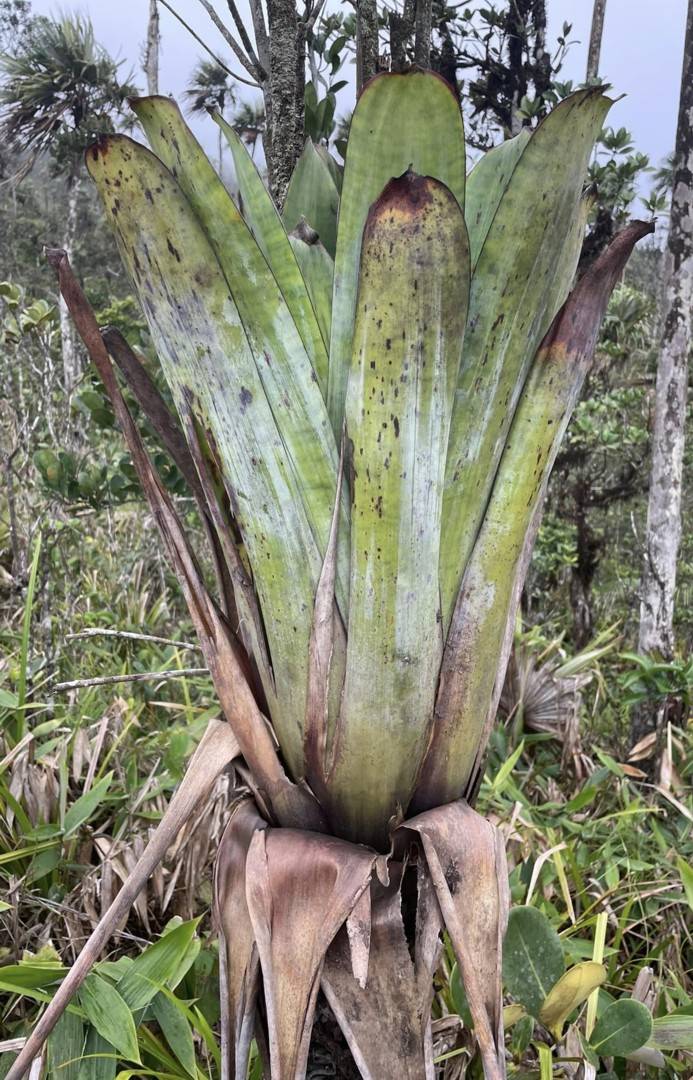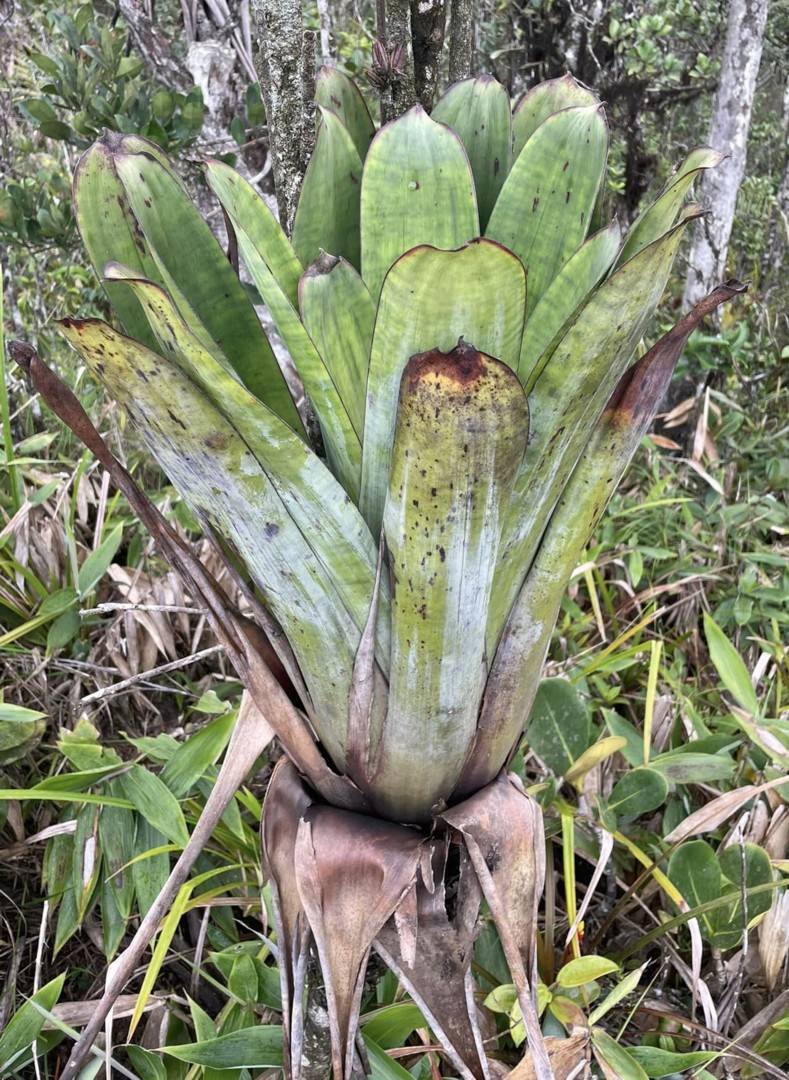


A W. umbrosa (L.B. Smith) J.R. Grant cui affinis, sed foliis erectis et glaucis, laminis margine purpureis, petalis gilvus vs. albis et purpureis differt.
Plant epiphytic, to 120 cm in flower. Stem woody, 7 cm in diameter, encased in decayed leaf sheaths.
Leaves upright in funnelform rosette, 55- 70 cm long.
Leaf sheaths elliptic, 24-30 cm long, persistent, without longitudinal purple-castaneous lines.
Leaf blades ligulate, apex acute to rounded and acuminate, 31-40 cm long, unmarked except for maroon borders, abaxial surface glaucous and foveolate.
Scape erect to curved erect, 59-65 cm long, 14 mm in diameter.
Scape bracts imbricate, acute, 5.5-10.5 cm long, pale green to red/maroon at base with age.
Inflorescence narrowly conical to sub cylindrical, rachis 21 cm long by 12 cm in width at base.
Primary bracts broad, cupulate, apiculate, 40-45 mm long x 37 mm wide at its broadest at the base.
Primary branches mostly 3-flowered in a sympodial arrangement; a fourth, aborted flower often being present. Distal lateral branches with 2 flowers.
Floral bracts acuminate, 22-30 X 15-16 mm, light green.
Flowers opening in early evening, zygomorphic.
Sepals rounded, 36 X 14 mm, green and glabrous with no markings.
Petals pale yellow.
Fruit a dry capsule.
Phenology. Observed flowering in late February, fruiting in early April.
Etymology. This new species is named for Harry E. Luther, not only in recognition of a life-time devoted to the systematics of the Bromeliaceae, but also due to the fact that he was in possession of a single undescribed specimen.
Habitat and physiological ecology. Aside from the location of the type specimen (Cerro Jefe in Central Panama), the authors have observed W. lutheri in Parque National El cope, Veraguas Province, Panama, and it has been collected by Harry Luther (figure 13) from Fortuna, Chiriqui Province, Panama.
The location of the type specimen, in common with other elfin cloud forest sites, is sparsely forested by trees of only 8-15 m in height (Carrasquilla, 1997), producing an irregular and open canopy, overshadowed by the occasional lanky Colpothrinax palm (figure 11). Stunted growth in elfin cloud forests is thought to be a result of the leaching of mineral nutrients out of the thin soils by high rainfall and high wind speeds in these exposed sites (Luttge, 1997), and also lower soil temperatures (Cavelier and Mejia, 1990; R. Gottsberger, pers. comm.). The relatively open canopy results in exposed conditions, with a dense understory experiencing either full sunlight, or relatively bright diffuse light through the clouds. Indeed, W. lutheri usually grows epiphytically in exposed situations at approximately 1-3 m height above ground level (i.e. just above the understory) at Cerro Jefe.
Cerro Jefe plays host to 45 endemic species and approximately 120 epiphytic species (Carrasquilla, 1987; Carrasquilla, 1997), including seven described species of the genus Werauhia. Only one of these – W. capitata (figure 12) - superficially resembles W. lutheri in the vegetative state in vivo. However, W. capitata attains approximately half the size of W. lutheri at maturity, and immature plants of the two species may be distinguished by the absence of a maroon border to the leaf blade in the case of W. capitata (for a full description of W. capitata see Utley 1983). Greenhouse-grown W. lutheri may produce softer leaves, with a more suberect habit (H. Luther, pers. comm.). Indeed, differences in the amount of dead leaf material retained at the base of the plant and variability in leaf length (see description above) may result in a fairly plastic vegetative habit in the wild.
Similarly the glaucous nature of the leaves may be quite variable, ranging from a light epicuticular wax layer restricted to the abaxial surface, to (rarely) an overt white layer covering both surfaces. Glaucous leaf blade surfaces act to repel water in the case of W. capitata (Pierce, Maxwell, Griffiths and Winter, unpublished data). Leaves of Catopsis micrantha from Cerro Jefe also possess extensive hydrophobic epicuticular wax layers, with fovelate pitting in such layers consisting of holes allowing the passage of gases between the air and the stomata (Pierce et al., unpublished data). Water repellency in these species apparently aids the maintenance of gas exchange and photosynthesis in wet habitats - the annual rainfall at Cerro Jefe being as high as 4000 mm (Valdespino, 1988).
In fitting with these mesic conditions, leaves of W. lutheri were not found to acidify during the night (i.e. DH+ = 0; n = 3; n = 3 via the method of Griffiths et al., 1986) with an aqueous extract of leaf blade material (300 mg fresh weight in 50 ml distilled water) having a mean pH of 7.55 ca 0.06 at dawn. This lack of acidification reveals that W. lutheri employs C3 photosynthetic metabolism, in common with the majority of bromeliads at this site (Pierce et al., unpublished data) and conforming with the remaining members of the genus (Crayn, Winter and Smith, unpublished data).